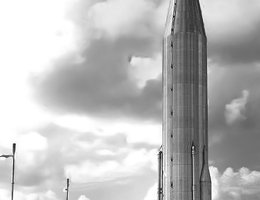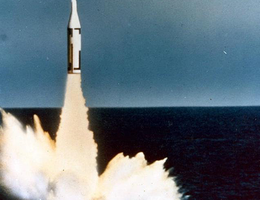

At first, SAC had airplanes with nuclear bombs. Their mission was to discourage another nation from attacking the U.S. by being ready to deliver a massive nuclear attack. But it was clear that rockets were the emerging weapon of the future.
The reason was speed. Bombers fly at less than 600 miles per hour. Missiles fly at 15,000 mph. Missiles have further to go because they rise high into space and then re-enter the atmosphere, but their incredible speed meant that weapons could be delivered halfway around the world in 15 to 30 minutes rather than hours needed with planes.
After World War II, the Navy, Army and the Air Force (after it split off from the Army Air Corps) were all working on competing missile programs. The Air Force concentrated their research on missiles with wings, rather than ballistic missiles. But that approach was limited, and the Army and Navy made progress during the late 1940s. During this time, captured German V-2 rockets were launched, studied and modified to provide more lift and better accuracy. But the Navy soon discovered that rockets burning liquid fuels were not safe to launch from ships or submarines. So the Navy began research into rockets that used solid fuels.
Finally, in 1956, SAC was given the mission of developing all the ballistic missiles that could attack targets at least 200 miles away. The Army was to develop shorter range missiles. And the Navy continued to work on solid fuel rockets for sea use. At about the same time, U.S. nuclear scientists told the military they could develop a much smaller nuclear bomb by the early 1960s. The CIA reported that Russian scientists were developing huge missiles to deliver their nuclear bombs. And then came Sputnik.

Development of the Inter-Continental Ballistic Missiles (ICBMs) with nuclear warheads became a huge priority.
The first test flight of the new Atlas missile took place in 1957, but out of the first eight missile flights, four blew up or failed to fly. Finally in 1960, Atlas missiles with warheads were set up in launch sites around the country. One was just outside of Lincoln, Nebraska. At these sites, the missiles laid down horizontally. If a crisis caused the President to order the missiles to be prepared for launch, they would be raised to a vertical position, fuel would be put into the missile and it would be fired.
In the years that followed, SAC would develop and deploy Titan missiles (in 1962), solid fuel Minuteman missiles (also in 1962) and Peacekeeper MX missiles (in 1986). All of these missiles were housed vertically in underground silos that were hardened to withstand anything but a direct nuclear explosion. They were controlled and maintained by local crews. At first, these crews had four officers. Later, two officers controlled the launch of the missiles.
In the meantime, the Navy was busy developing solid fuel rockets that could be launched from submarines cruising undetected underwater. The Polaris missile was put into service in 1960, three years ahead of schedule. It was followed by the Poseidon and Trident missiles.
So, by the early 60s, the U.S. military had nuclear weapons pointed at the Soviet Union, and the deadly game of deterring an attack began. It became clear that there needed to be a single plan of attack — it would not help if a SAC underground missile and a Navy submarine missile both attacked the same target. So, Navy personnel were assigned to SAC and both groups came up with a "Single Integrated Operational Plan" (SIOP) that targeted each of the thousands of nuclear bombs — whether it was on a plane, in a silo or on a sub — to individual targets in the Soviet Union.
For over 50 years, all of these nuclear arms from the U.S., Russia, and later England and France were pointed at each other. Everyone was trusting in the strategy called "MAD" — Mutually Assured Destruction. That meant that if anyone launched a nuclear bomb, it would result in a massive retaliation from the others. This threat would stop any nation from striking first. There have been some close calls, like the Cuban missile crisis, or technical glitches that almost resulted in launches. There have also been reductions in most country’s nuclear arms, but, so far, the threat is still working.
Find out more about False Alarms in the Nuclear Age from PBS Nova.